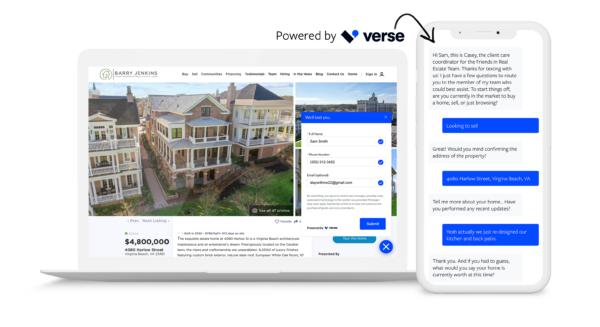How to Nurture Leads: Untapped Potential for Sales and Marketing Teams
How Companies Can Leverage AI for Lead Generation and Engagement
Nurturing leads is a vital practice for both sales and marketing teams. According to Forrester, businesses that nurture leads make 50% more sales, while nurtured leads incur 33% less cost than non-nurtured ones.
How can sales and marketing effectively nurture leads for the best conversion rates? How can companies harness emerging AI for lead generation?
This comprehensive guide aims to answer these questions and more, focusing on four high-return ways to improve your lead nurture strategy.
What is Lead Nurture?
To nurture a lead means to build a relationship with potential customers and guide them towards making a purchase decision. Lead nurture focuses on creating and maintaining an authentic relationship with the customer, fostering trust, and addressing the customers’ needs and concerns.
Nurturing leads falls on both sales and marketing, with best results achieved when these teams work together.
In a practical sense, lead nurturing means continually contacting leads (in a compliant fashion, of course) to qualify them. Eventually, the lead should ideally convert by taking an action such as purchasing or booking a sales call.
While the end goal of lead nurturing is to convert the lead into a paying customer, it also ensures that leads don’t forget you exist. Remember, customers are not going to meet you on your terms. Meet them where they’re at, or they’ll forget you.
Why Lead Nurture is So Important
Nurturing leads is vital to both your sales and marketing strategies because it qual
ifies leads and converts them into customers. In fact, nurtured leads make purchases that are 47% larger than non-nurtured leads.

Marketing leads are not free—they can cost over $1,000 each in some industries. The majority of marketing teams allocate more than half of their budget to lead generation.
However, 73% of leads are not ready to buy, so companies should be nurturing the lead, rather than rushing them into a purchase.
Aside from driving sales, lead nurture has several other benefits, including:
- Educating potential customers about your products and your company by, over time, showing them a more complete picture of who you are and what you offer.
- Fostering trust by giving leads helpful information, demonstrating your knowledge, and addressing their pain points.
- Keeping your brand top-of-mind. When you communicate with them regularly, they’re less likely to forget you.
- Correctly utilizing funds—you’re spending valuable money and time acquiring leads, it’s only logical to invest in growing those leads into purchases.
How to Nurture Leads
When nurturing leads, there are four main focus areas that both marketing and sales teams must pay attention to for the best results:
- Respond to inbound leads fast. When fostering relationships with your potential customers, it’s absolutely vital that leads who request to be contacted are reached as quickly as possible.
- Generate high-quality leads. As you want to create genuine connections with your leads, you should be nurturing first-party leads that have shown interest in your business.
- Continually provide content. Most leads aren’t ready to buy right away, so marketing teams need to continue to feed them personalized content, meeting their needs and developing brand trust.
- Manage and score leads effectively. Once you’ve generated leads, you must use the right technology and methodology to organize them properly.
Lead Response Time is More Important Than You Think
Arguably, quick time to lead response is the most neglected, yet most vital part of lead nurturing.
When leads fill out a form requesting next steps, it’s extremely important that your company follows up, nurturing that connection and building an authentic relationship with them—and fast. Why is speed of the essence?
Well, it’s not just speculation.
Leads are 21x more likely to convert if they are contacted within 5 minutes of filling out a form.
Even after just one hour, the likelihood of successfully contacting a lead drops by 10x, and the odds of qualifying that lead drop by 6x.
Research shows that 78% of customers will choose the organization that contacts them first.

This logic makes sense; when buyers fill out a contact form, they are ready to talk. Plus, consumers are generally not very patient—if you don’t meet them where they’re at, they’ll find someone else.
While the benefits of more immediate contact are crystal clear, most organizations are not executing on these facts.
In a study by Harvard Business Review, 47% of businesses fail to respond to leads within 24 hours, while 37% of companies responded to their lead within an hour.
As 16% responded within one to 24 hours, 24% took more than 24 hours—and 23% of the companies never responded at all. Among the companies that responded, the average response time was 42 hours.
Notably, a study by Lead Response Management showed that after 20 hours, additional call attempts actually have a negative impact on making successful contact.
Understandably, time is a huge limiting factor for sales teams, but they must start prioritizing early lead engagement. Five minutes seems to be the golden window.
Every hour that goes by without contact, leads begin to:
- Feel neglected
- Lose interest
- Forget you exist
- Go to your competition
While automated lead nurturing is useful, a follow-up email, call, or text is priceless when it comes to an inbound lead. When the lead is contacted within five minutes of their form fill, your chances are exponentially higher.
Contacting inbound leads at the right time is far more effective than cold calling because:
- The inbound lead WANTS to hear from you.
- Since you can see their recent behavior on your website, and you have more data, you can personalize messaging.
Improving Lead Response Times
When improving lead response times, it’s best to start by understanding what your current lead response time is. After all, you can’t improve what you can’t measure.
Equipped with this data, you must continue to track it, and analyze how response times are affecting your lead conversion and qualification metrics.
In addition, you must develop a strategy to reduce time to lead response, which may include:
- Tracking response time by rep to see who is falling behind, and then take steps to help those reps.
- If times are unsatisfactory for the entire team, you could offer training.
- If you can afford it, hire more reps to improve the average speed of response.
Alternatively, you could employ a platform like Verse.ai to automatically follow up with every single lead within five minutes.
Through the Verse platform, when a lead fills out a form, your advanced AI rep texts them immediately.
Unlike most automation services such as chatbots, our AI:
- Texts as a real human.
- Is equipped with your expansive, custom scripts.
- Is quality-controlled by human concierges. (If it doesn’t know how to respond, it will pass the inquiry to a real person.)
- Effectively qualifies leads.
With the power of Verse, lead response times are quicker than ever—guaranteed. Our AI ensures that no customer is left behind, feeling neglected, or left to pursue your competition.
Generate High-Quality Leads
When nurturing leads, you want to nurture leads that are open to a relationship with your company—not leads who have no idea who you are and how you got their information.
For this reason, it’s crucial that your marketing strategy focuses on first-party leads: leads from your brand’s channels, who voluntarily give you their contact and express interest in your product.
While generating your own first-party leads can be difficult, there are many tactics that can be effective.
Why Not Buy Leads?
Buying leads from lead generators (a third party) may be a standard business practice, but it’s quickly becoming outdated (and in some cases, illegal).

Third-party leads may not know who you are and did not request to be contacted by you specifically, leading to several drawbacks:
- They may not want to receive your calls, emails, or texts, and contacting someone who doesn’t want to be contacted is intrusive and erodes trust.
- As of January 2025, per the FCC, it will be illegal to contact leads that did not fill out a contact form requesting information from your business specifically.
- Since they may not know who you are, third-party leads are less likely to convert, making outreach to them a questionable use of time.
While third-party leads may be an easy lead generation tactic, it’s exponentially better to generate your own leads rather than buy.
Marketing Lead Generation Tactics
Unlike third-party leads, which are generated through, well, a third party, first-party leads are generated for your business, by your business.
Inbound marketing is a lead generation tactic that attracts customers to your business through information and content sharing.
For example: a potential customer discovers your website through a Google search, social media, etc. They then find one of your ebooks with data that entices them, and decide it’s worth it to provide their contact in exchange for the resource download. They are now a lead as a result of inbound marketing.
Inbound marketing is about promoting your brand’s content in order to drive lead generation. There are many ways to do this, including:
- Website and SEO. Through creating useful content for your customers, you can drive traffic to your website, improve search engine optimization (SEO) so that leads can more easily find your website on Google.
- Social media. Consumers can find and engage with your business’ social media content, clicking through to your website to become a lead.
- In-person events. Attendees can become a lead while visiting your booth or after learning about you at the event.
- Product trial. By offering a free demo or trial on your website, you can entice customers to fill out a form in order to experience your product.
- Digital ads. Through social media ads or pay per click, you can get more leads to consume your content on your website.
How Marketing Nurtures Leads
Okay, so you’re generating first-party leads and following up with leads who are ready to talk. What about everyone else?
Although 73% of leads are not ready to buy, 61% of B2B marketers send all leads directly to sales.
Marketing teams should utilize their various channels to continually provide those leads with valuable, personalized content—nurturing the lead.
Nurture happens through multiple channels and many touches in order to keep your brand top-of-mind and develop trust by providing useful information.
Often, the process for lead nurture is similar to inbound marketing, as it’s continually marketing to consumers in a way that gives them something.

Here are a few ways that marketing can nurture leads:
- Email marketing. This channel can be highly personalized through lead data, and allows you to provide leads with relevant resources over time.
- Social media. When leads follow you on social media, you can continue to nurture their interest by posting exciting news and relevant content.
- Events and webinars. Whether in-person or online, events can educate leads and/or give leads more about your brand.
- Product trials. Offering a free trial at the right time may give leads the push they need to be truly sold on your product.
- Blog posts. Writing a consistent blog can help leads become loyal subscribers to your brand and provide them with helpful content.
Understand Your Industry
Depending on industry and length of the sales process, lead nurturing can look different.
According to research by the RAIN group, it takes an average of eight touches to convert a new lead (conversion means booking a meeting or the industry equivalent).
However, this can vary significantly depending on industry, price point, and the quality of your touches. For example, converting a lead for an expensive B2B technology subscription will take much longer than a B2C lead buying a hairbrush.
It’s important that marketing teams understand these factors and plan touches accordingly.
Regardless of industry, brands should always strive to serve up high-quality content for their leads that helps them solve a problem, addresses their concerns, educates them, etc.
Higher-quality touches help to improve brand trust and generally results in less touches to convert.
Lead Management and Scoring
As you’re generating leads, it’s paramount that you are keeping track of lead data, engagement, and level of interest.
Sales and marketing must both use the correct technology, including CRMs and automation, in order to streamline lead engagement.
In addition, both teams should come together to define parameters for scoring leads to gauge each lead’s interest.
Sales CRMs
For proper lead management, sales teams need to utilize CRMs (customer relationship management system) in order to document the sales process as well as lead engagement.
Popular CRMs such as Salesforce support lead nurturing by notifying sales of new leads and documenting who has been responded to, when it was sent, and what the interaction was.
Marketing Automation
Automated lead nurturing is a cost-effective way to nurture leads in a personalized manner.
Automation is more efficient than direct email and is capable of mass-sending messaging to segmented lead groups, meaning that messaging can be sent at a high level and personalized based on leads’ behavior, industry, job title, and the like.
Through email marketing, businesses can maintain brand awareness and build connections with leads as they move through the customer journey.
With automation platforms such as Adobe Marketo or Hubspot, you can also track customer data and behavior and utilize this data to both optimize campaign content and gauge interest.
How to Score Leads
Lead scoring is important to lead nurturing. Because not all leads will express high levels of interest right away, you must discern which leads are hungry for more information right now, and which are not ready yet.
Lead scoring is the process of assigning numerical value to lead actions in order to rank their interest.
For example, a lead that spends time browsing your website and clicks through every email will have a higher score than a lead that only opens 20% of emails.
When scoring leads, you can choose how many points each action is “worth”; for example, clicking through an email may be assigned a lower value than requesting a demo.
Scoring allows sales teams to prioritize their efforts, focusing on leads that are engaging with your brand’s content.
Marketing can tailor content based on the lead’s score; for example, offering a free product trial once the lead score hits a certain number.
Sales and Marketing Alignment
The final piece of the puzzle of lead nurture is true sales and marketing alignment. When both teams are united behind their approach, lead nurturing is more successful.

Marketing and sales teams should work together to answer questions such as:
- How are we scoring lead actions?
- When or at what lead score should a lead move from marketing to sales?
- What content would our potential customers find most valuable?
- How should we segment our audience?
- What are the expectations for each team?
It’s best practice to then outline expectations for collaboration in a sales and marketing service level agreement (SLA).
It’s a tale as old as time: marketing blames sales, sales blames marketing.
However, the best results are produced when both teams work together from a place of mutual respect, focused on the common goal: more closed deals. It’s time more teams embraced this idea.
Without a unified approach, your lead nurturing strategy will never work as it should.
AI for Lead Generation and Engagement
In today’s competitive, tech-enabled landscape, it’s more important than ever to leverage the right technologies for effective marketing and sales strategies. In fact, both lead nurture and lead generation can be improved with strategic use of AI.
Hubspot reports that 25% of marketers who had effective marketing strategies in 2023 used AI and automation tools—as opposed to only 5% of marketers who had ineffective strategies. Why?
The job of AI in this context is not to replace human work or interaction. Instead, platforms like Verse.ai provide instant lead engagement, resulting in conversations that nurture leads, qualify them, and drive warm leads to your sales team or call center.

AI-enabled lead engagement can be far more efficient than the traditional approach, where:
- Salespeople engage on their own timetable.
- Leads may be forgotten, missed, or left without follow up.
- Lead response times are long and varied—which often results in calls to cold leads.
- There is no lead engagement during off hours.
Meanwhile, Verse.ai’s platform provides instant lead response for every customer, works 24/7, ensures follow up, and communicates via multiple channels, including text.
 As far as lead generation, AI tools like Verse.ai promote lead capture through engagement.
As far as lead generation, AI tools like Verse.ai promote lead capture through engagement.
By creating a pop-up form on your website, we take inbound leads and start nurture instantly by engaging them in a two-way, AI-powered text conversation.
By utilizing AI for lead generation and lead engagement, companies enable:
- Faster lead response times, 24/7
- Greater first-party lead generation
- Automated lead nurturing
- Less time wasted by sales teams
- More qualified leads for sales teams
Why Verse
Combining AI, instant response, and effective lead nurture can help boost the number of deals closed, qualified leads, leads engaged, and average deal size. And that’s exactly what we do.
Verse.ai is the sales and marketing AI of the future, helping teams generate and nurture leads like never before.
Our conversation platform combines AI-powered technology and highly skilled concierges, who provide quality assurance and step in if the AI cannot confidently answer.

Our mission is to give your leads a satisfying, cohesive and personalized brand experience—while helping teams drive more revenue opportunities from their lead generation and sales investments.
Through an omni-channel approach, Verse nurtures leads for up to six months, intelligently engaging with them at times they are most likely to respond. Since consumers prefer text, we use that the most.
79% of marketing leads never convert into sales due to lack of lead nurturing. Don’t let the value and investment in your database go to waste.
Learn more about how Verse.ai can help your company.


